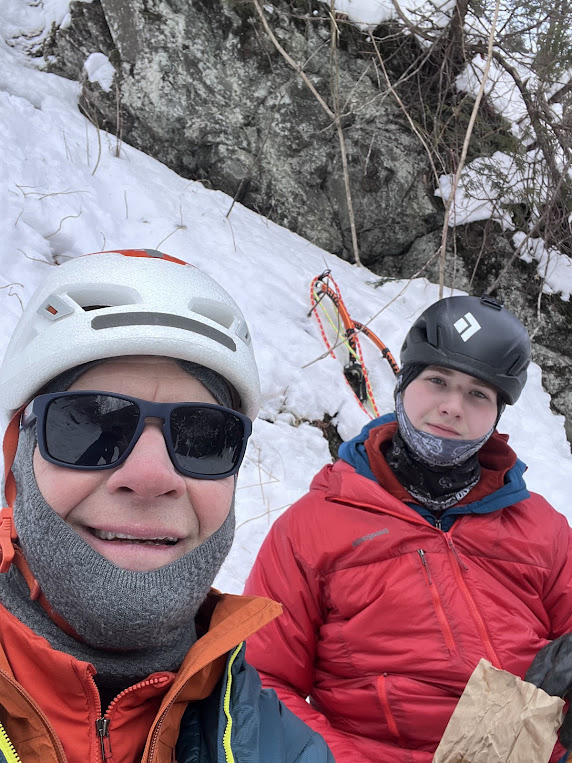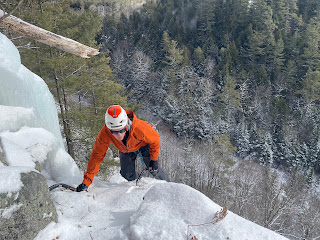Disclaimer: I'm lucky if I ski 10-20 days a year. While I ski every year, and the proportion varies, maybe half of that is backcountry on average. I have much less disposable time than skis. That stated, I love a well-made pair of skis (or boots, or skins, or poles), and they do have a positive impact on those days sliding on snow.
Low on the Vallé Blanche in 2011
Photo © Sylvain Ravenel
When I first skied in Chamonix, I had graduated from the old rust-colored Garmont boots to their better blue cousins. But what really moved the needle was my graduation from some old skis and bindings to my first pin binding setup. The old ones were now 20+ year old Black Diamond (likely made by Atomic) 'randonee' skis, which were actually very stiff, narrow, kinda heavy skis with Silvretta EZ-Gos on them (I still use them for approaches in climbing boots.) The 'innovation' was a Dynafit TLT Superlights on a truly lovely pair of Trab Stelvio skis. Not picking up an extra pound with every step was pretty transformative, and when a few years later I moved on to the Dynafit TLT5 boot with it's butter-like walk mode, I was sold on the transformative power of lighter weight gear. And because I was and am an avid reader of Dane's blog, https://coldthistle.blogspot.com/, I started learning more about them, and my go-to resource since then, Jason and the team at skimo.co in SLC.
I could still ski on the Stelvios and the TLT superlights with those TLT5s, and sometimes do. I had a decent pair of Ascension skins from BD fitted to them which are still going strong about 15 years later. One thing I did not buy with them was a leash. My first time off the Midi I almost lost a ski right at the top in high wind. Never again. I understand the convenience of brakes, and the logic of shedding skis in an avy, but had I missed the 20 klicks of the descent I would have been very unhappy. I improvised some leashes with thin cord at Snell Sports right after taking the train down from Montenvers and then went and got some proper freaking leashes (ATK, Dynafit, whatever the credible folks make.) I will ski with brakes happily at times and with nothing when appropriate, but would not be skiing those Stelvios today had I not recovered a split second gust which could have easily taken one away. And another thing. I was up in Tucks for the spring (aka the silly season) with my then pre-teen. We were being joined by a very solid partner Mr. Max White https://www.thisismaxwhite.com/ approaching us from lower down Lunch Rocks. He started hollering as a group of 2 adults and 4 kids younger than my guy were crossing below Lobster Claw. Max was yelling because a runaway ski was looking to make a kid kebab. Fortunately the group hustled along, and the hoards saw it too, so nobody was hurt. But I still like leashes.
However, I have not been able to resist the profusion of amazing skis the market and some very special craftsmen and women have brought us over the past decades. After the Stelvios I was looking for a ski with more rocker and sidecut. I might claim that was because I knew what I was talking about, but that would be a lie. I had read extensively about the Denali by Dynafit, and liked what I read. For me the 99 mm waist would be a powder ski, comparatively, and some duder convinced me to go with 184s, almost as tall as me. Fortunately I do generally ski them in powder, and so the length has not been an issue, but Andrew McLean once told me that 180 is about as long as you want to maneuver on a steep powdery kick turn, and generally he's correct, unsurprisingly. That ski does turn like a dream in a bit of soft snow, and is surprisingly able to navigate hardpack, on piste, Tatra-style grabber slush and lots of other stuff. And they are remarkably light, especially with the TLT Low Tech. I do not always feel as secure on those bindings as I would on one with more mass, but situations where I lock the toe are the same across all bindings (it's steep, it's hard/chattery, you better not fall,) so I think the weight tradeoff is worth it, even if I have generally rocked heavier bindings on my skis since then.
Andrew McLean on Kessler during a dreadful snow year (2012)Once I had a chance to take advantage of skis that were 80 mm or 99 mm in the waist, it was pretty easy to choose: the former generally suited the east, the latter the west. I was hooked, and not due to skis that felt hooky. In spite of detuning skis and tuning skis aggressively, which I enjoyed until my son surpassed me and took over most of those duties (he won't let me touch them much anymore...such a perfectionist,) I did discover the perils of too well-waxed skis at times. Once camping with Andrew we ended the day on a flat shelf heading to the tent, and my freshly waxed boards made for a hilariously slow progress on about 150 feet of terrain I could barely move across with a 6 inch shuffle. And more recently said son waxed our approach skis so well we almost ended up in low orbit descending Pitchoff North Face in climbing boots...
In the years that followed I wandered a bit, getting some very short mountaineering skis I've rarely used (Atomic Ultimate 78s with Low Tech binders) and a nice pair of Moment Vertex (basically a lighter Stelvio with some rocker) which introduced me to Plum bindings. The Plum Guide has been a mainstay for me and the family for a while, and while I have zero issues with the Dynafits I own, I do like the burliness of the Guide, even though I managed to ski off the toe latch once (pilot error) barely avoiding a new skier at Jay who turned into me, but not before clipping off said latch. I have those same Guides on a pair of Black Crow Navis Freebirds, which are a classic big ski mountaineering ski I love to use in Jackson or anywhere you get real powder to play around on. If I need a bit more ski, I use their Atris, which I have in a crazy 189 cm length due to a bro deal from Max and mounted with Shifts, which are inelegant but perfect as I use them primarily on piste and sidecountry.
More recently I have gone back to Trab, getting a pair of their Magico skis with a Hagen/ATK Core 10 binding. It is a beautiful setup, especially for light/fast missions and mountaineering where you want <90 in the waist and <180 in length. It also boasts the only skin system which rivals that of Dynafit's own version of remove from the tip, and appears to me to be a bit more secure. While limiting your skins to that ski, the proprietary tip or tail attachment of the Dynafit or Trab Attivo is well worth a look, especially as the hips have never been so flexible in my case. I have also used race tip bungees and like that system for lighter setups and quick transitions. Speaking of skins, when I'm not using the proprietary type I like Pomocoas, and have some Mohair for the Navis which are perfect, maybe a bit heavy compared to their pink cousins ('Free'?) which Toby sports on his Corvus Freebirds, but fine for me over the years.
Now I have been contemplating the gap between my 85 mm Magicos and the 99 Denalis....something wicked this way comes.





